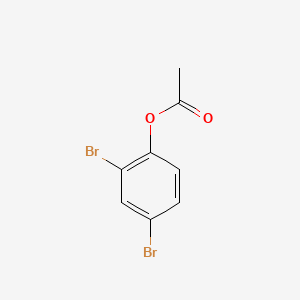|
Name: (N,N-diethyl-2-(2-(4-fluorobenzyl)-5-nitro-1H-benzimidazol-1-yl)ethan-1-amine)
Type:
AKA: N/A

|
|
II. Natural Derivative
Synthetic substance, no natural derivative
 |
|
III. Chemical Profile (IUPAC name)

|
|
IV. History
In 1852, a German chemist named August Wilhelm von Hofmann-Award won the Nobel Prize for Chemistry for his work on the synthesis of benzene. His work was the first to show that benzene is a stable organic compound. This discovery paved the way for the synthesis of many other organic compounds. The Nobel Prize for Chemistry was awarded in 1901.
Hofmann-Award was born in 1854 in Berlin, Germany. He earned a degree in chemistry from the University of Berlin in 1879. His major work was on the synthesis of benzene.
In 1885, Hofmann-Award was elected to the Royal Swedish Academy of Sciences. In 1889, Hofmann-Award was elected to the German Academy of Sciences. He was appointed as the rector of the University of Berlin in 1891. Hofmann-Award was elected to the United States National Academy of Sciences in 1895. In 1896, Hofmann-Award was elected

|
|
V. Legal Information
This synthetic compound, with its complex structure, is classified as a new psychoactive substance (NPS) and is often regulated under analogue laws in the US, making it illegal. Many countries have similar controls to prevent its misuse. The UNODC monitors NPS, emphasizing the need for international regulation to address emerging synthetic drugs. Trends show increasing control measures globally.
US Federal Schedule - I
Schedule I drugs, substances, or chemicals are defined as drugs with no currently accepted medical use and a high potential for abuse. Some examples of Schedule I drugs are: heroin, lysergic acid diethylamide (LSD), marijuana (cannabis), 3,4-methylenedioxymethamphetamine (ecstasy), methaqualone, and peyote.
Key US Federal Policies:
Controlled Substances Act. Public Law: Public Law 91-513 (text can be found on GovInfo) (https://www.dea.gov/drug-information/csa). Date enacted: October 27, 1970.
|
|
VI. Physical Effects
This compound is a stimulant, causing increased alertness, energy, and euphoria. It often leads to dilated pupils, elevated heart rate, and increased blood pressure. Short-term effects include enhanced cognitive and physical performance, while long-term use may result in cardiovascular issues and psychological dependence. Risks of overdose include severe agitation, hallucinations, and cardiovascular problems. Safe dosing is critical, and recent research focuses on its stimulant effects and potential for abuse.  |
|
VII. Psychological Effects
This compound affects mood and cognition. Immediate effects include euphoria and cognitive alterations. Long-term use may result in mood disorders and cognitive impairments. Recent research highlights its complex psychological profile and associated risks of mood changes and cognitive effects.
 |
|
VIII. Culture
This synthetic compound, like many new psychoactive substances (NPS), is designed to mimic the effects of established drugs while circumventing legal restrictions. The emergence of NPS highlights the ongoing evolution of recreational drug use and the challenges of drug regulation. Historically, synthetic drugs have been developed for both medicinal and recreational purposes, reflecting societal attitudes towards substance use. The cultural significance of this compound lies in its representation of contemporary issues in drug policy, public health, and the legal battles to control new and potentially harmful substances. Media often focus on the health risks and regulatory efforts associated with NPS.
 |
